Willkommen: Hier finden Sie die deutsche Fassung des Briefes aus BerlinWelcome to our March Letter from Berlin! This Letter from Berlin is dedicated to our current Art Basel OVR: Pioneers presentation. After a short essay on the history of the term pioneer, we introduce the works by General Idea, Dominique Gonzalez-Foerster, Pierre Huyghe, Ann Veronica Janssens, Philippe Parreno, Anri Sala, and Hito Steyerl featured as part of our selection in Art Basel OVR: Pioneers, and present a conversation with Tino Sehgal and Svetlana Marich on the artist's practice. As part of our series All Access, a video takes you into Sun Rise | Sun Set with Pierre Huyghe's aquarium work at Berlin's Schinkel Pavillon. David Claerbout's solo exhibition opened yesterday at the Garage Museum in Moscow. Karin Sander's sole presentation opens tonight at the Kunsthalle Tübingen. Find the links to attend the digital opening and exhibition tours with the artist below. Our recent Spotlights on works by Angela Bulloch and Ann Veronica Janssens, as well as a selection of books round up this month's newsletter. We hope you enjoy our Letter from Berlin!
|
|
|
What is a pioneer? A short history
pioneer (n.). 1520s, "one of a party or company of foot soldiers furnished with digging and cutting equipment who prepare the way for the army," from French pionnier "foot-soldier, military pioneer," from Old French paonier "foot-soldier" (11c.), extended form of peon (see pawn). Figurative sense of "a first or early explorer, person who goes first or does something first" is from c. 1600. Related: Pioneers.
– Etymological Dictionary
Language is in constant flux. Confinement, say, at some point referred to a specific period in which pregnant women were isolated; now it is a global phenomenon. Other changes are more gradual yet travel across equally wide disciplinary distances.
Pioneer is such a term as well. Like avant-garde, pioneer has its origins in military terminology. Only that it is much older, and in its root, from medieval Latin pedo for foot, is more concrete: inherent in the designation of foot soldier was apparently the assumption of being literally flatfooted.
Even ornament has a distant cousin in the military. It shares a root with the word order which has its origin is in the neat vertical and horizontal rows of yarn aligned on a loom. Order, from ordo, meaning row, rank, series, had the early connotation of military units, lined up in neat, deadly rows.
But pioneer shed its narrow militaristic association already in the 16th century, unlike the much younger word avant-garde, in use for military formation in the late 19th century: “A first or early explorer, person who goes first or does something first.” Perhaps a function of the Age of Discovery, then in full force. And just in time for the Enlightenment, one may suggest, as images of seafaring collectors of plant specimens, wiry mountaineers, or the icicled beards of arctic explorers come to mind.
Some of these “adventures” conjure up more ambivalent, even troubling images: the discoverers, explorers, as conquistadors and colonizers; one people claiming territory from another, jungles conquered, or, in enlightenment parlance: virgin forests tamed. Nature firmly dominated by culture.
What makes an artist a pioneer?
It was the wont of the finest spirits in all their actions, through a burning desire for glory, to spare no labor, however grievous, in order to bring their works to that perfection which might render them impressive and marvellous to the whole world; nor could the humble fortunes of many prevent their energies from attaining, to the highest rank, whether in order to live in honour or to leave in the ages to come eternal fame for all their rare excellence.
– Giorgio Vasari, from the preface to the 1568 edition of Lives of the Painters, Sculptors and Architects
The very nature of what makes an artist stand out is a mystery. Giorgio Vasari, in a founding document of art history, tried to describe the momentous change that took place in Italian art around 1300, tracing it through subsequent generation into his lifetime. His exhaustive history cannot answer the question of what allowed one artist to create pioneering work, and not others. He tries: biography, education, talent, genius.
But Vasari’s book represents in itself the vagaries of history, as parameters of judging an artist’s achievements have continuously shifted over the centuries—fame, money, patronage, critical esteem, and influence among contemporaries or in subsequent periods. It is impossible to predict, as it was for him, around whose work history will rally. Yet some figures even then stood out—and reading Vasari’s appreciation of their work, lets us partake in something approaching a consensus of their accomplishments across time.
The artists we assembled for this presentation of pioneers have redefined what an artwork is or can be. In terms of its formal manifestation, medium, and/or significance. Many of the artist have expanded the notion of an artwork into a time-based interaction with the viewer, conceiving of the encounter with the work as an open and open-ended experience. Tackling age-old subjects and topical issues, engaging with human existence in poignant and powerful ways, these works are pioneering in the best sense of the word.
–Isabelle Moffat
|
|
|
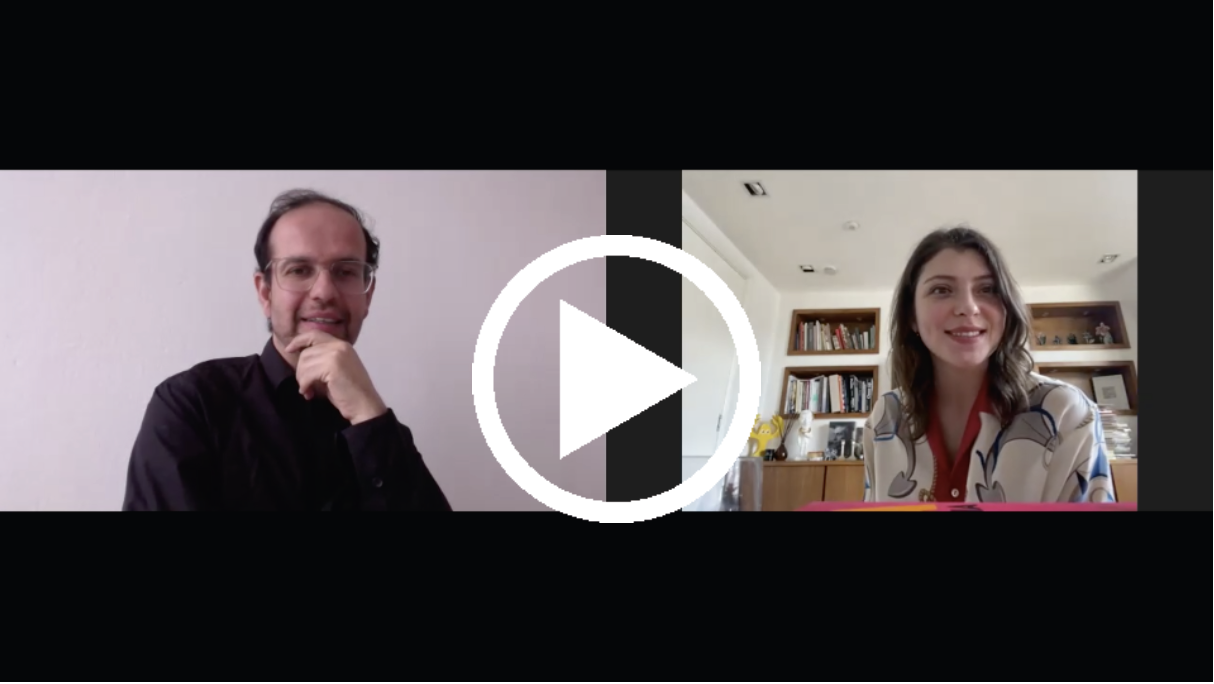
| Click the image to watch the full interview | |
|
For over twenty years, Tino Sehgal’s work has radically shifted the parameters of what a work of art is and can be. Educated in political science and dance, the artist conceived of an immaterial practice, or as Sehgal puts it 'temporarily materialized' in the actions of its interpreters. Sehgal’s 'constructed situations' manifest through the medium of highly trained interpreters of unscripted encounters guided by predetermined rules. The artist sets rules about the interpreters’ interaction with their audience, generally museum visitors, often also precisely specifying their movements.
The works manifest as human action, creating encounters, experiences, memories. The observer’s experience is the work. Drawing on the tradition of oral storytelling, these works are installed as paintings or sculptures might be: over extended periods, not as timed events, but on view during an institutions’ normal opening hours.
An important component of Sehgal’s practice is the variation of works in each observer’s experience. Hand-in-hand with the artist’s emphasis on the ephemerality of these human encounters, he discourages image-based representation and written description as incomplete documentation.
Therefore, the presentation for 'OVR: Pioneers' takes the form of a dialogue: in a short video Tino Sehgal and Svetlana Marich, Worldwide Deputy Chairperson at Phillips auction house speak about the artist’s practice. The wide-ranging conversation is introduced by Manuel Miseur, Director at Esther Schipper.
|
|
|
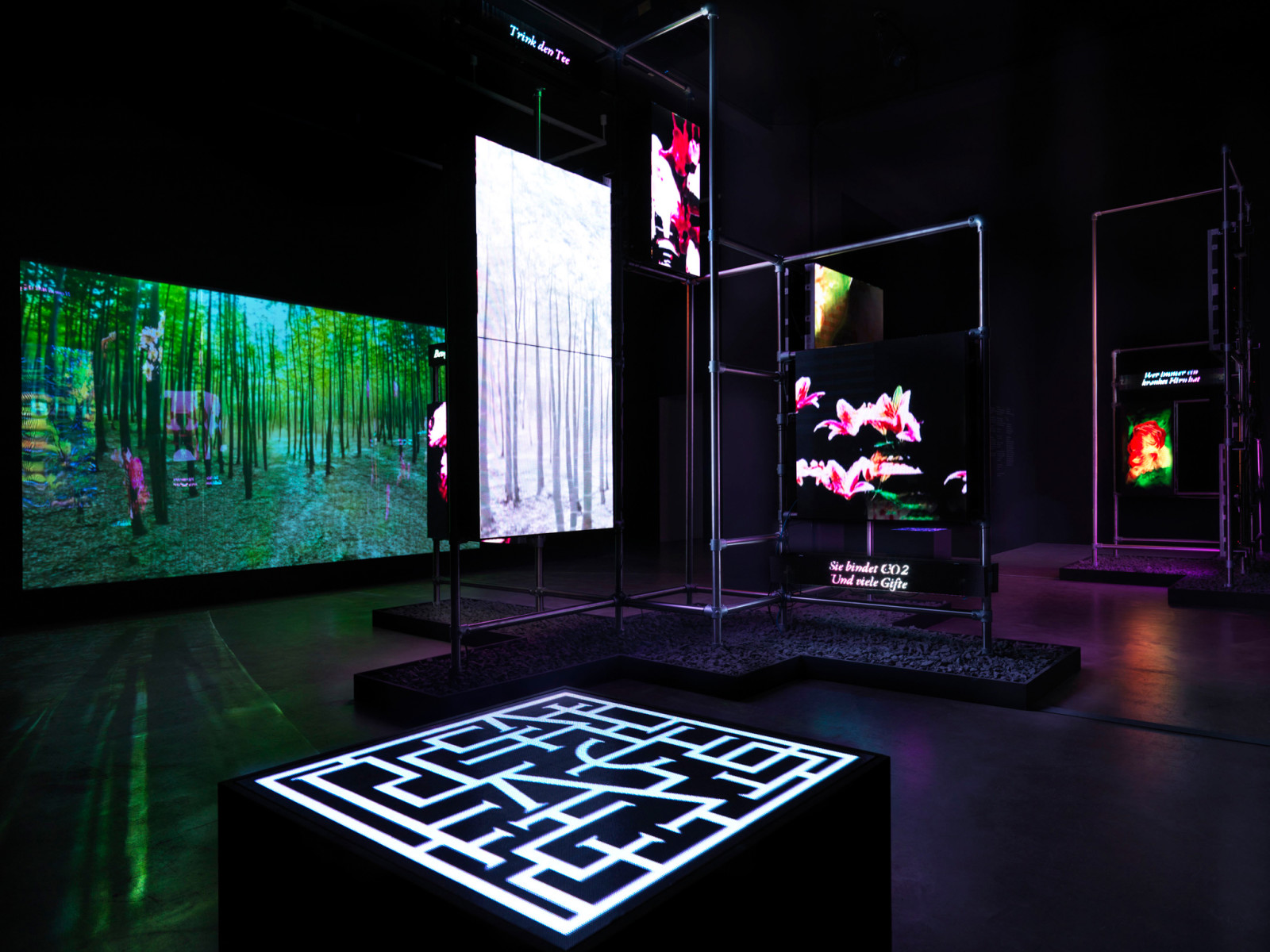
| Hito Steyerl, This is the Future, 2019, Video installation, environment, installation dimensions variable, duration This is the Future: 16:00 min. Exhibition view: Hito Steyerl, Neuer Berliner Kunstverein – n.b.k., Berlin, 2019–2020
© VG Bild-Kunst, Bonn, 2021. Photo © Jens Ziehe
| |
|
This is the Future is an environment and video installation, originally conceived for the 58th Venice Biennale. Its spatial configuration is site-specific and includes elements of other works by the artist.
In Venice, visitors were invited to wander among reinterpretations of the typical Venetian raised walkways—wood and metallic structures that are temporally installed in the city of Venice during episodes of flooding, also known as Acqua Alta. In the next iterations of the work, these structures were replaced by a framework of modular tubes, LED panels and projection screen presenting two video works: This is the Future and Power Plants.
|
|
|
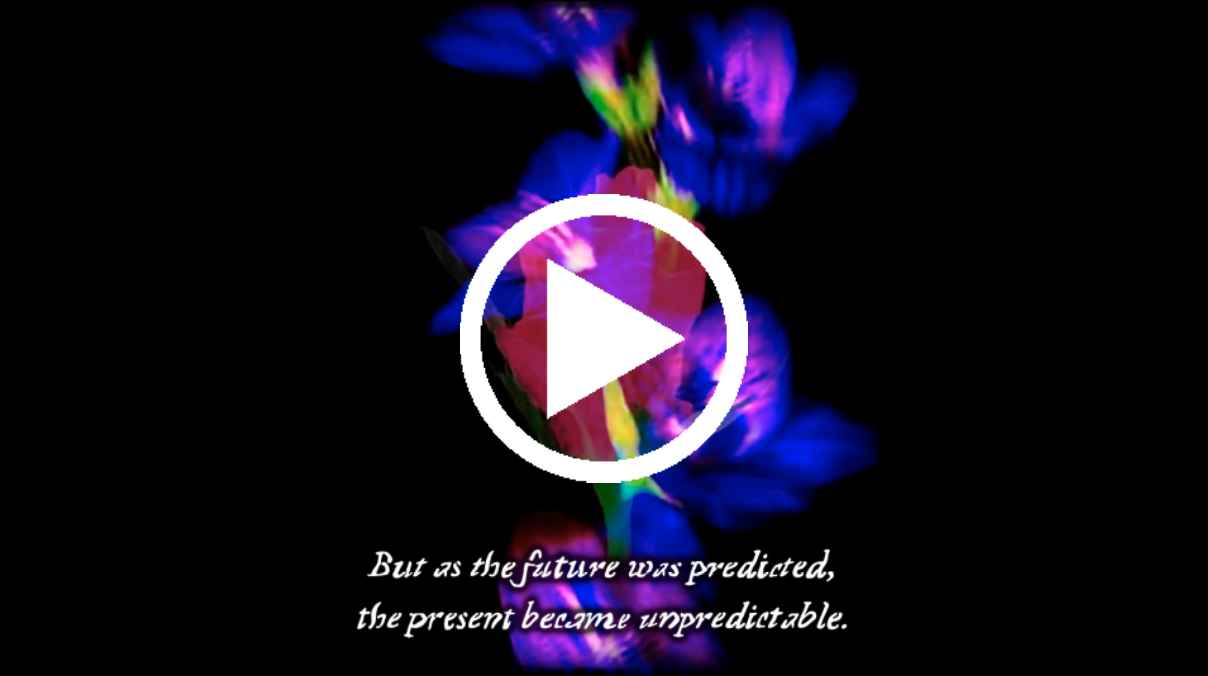
| Click the image to watch | |
|
In This is the Future, the film’s narrative follows a young Kurdish woman, Hêja Netirk, who relates how she and her cellmates tried to grow edible plants in the Turkish jails they were detained in, before she sets out to find the garden that she had to hide in the future in order to protect it. The installation also includes Power Plants: a multi-channel film—initially conceived for Steyerl’s 2019 project at the Serpentine Galleries.The work features digital flowers generated by neural networks: computer systems modelled on the human brain and nervous system, which are programmed to predict the future by calculating the next frame in the video. The artist has used this Artificial Intelligence to create a series of ‘predicted’ plants that are located precisely 0,04 seconds in the future, connecting to the visual landscape of the surrounding park.
The installation is inspired by the idea of a ruderal garden: an ensemble of plants that grow out of waste ground, perhaps in the wake of human disruption or destruction. Predicted by Steyerl’s neural networks as a vision of the future, this environment is a garden rich with plants that have various ecological, medicinal and political powers.
|
|
|
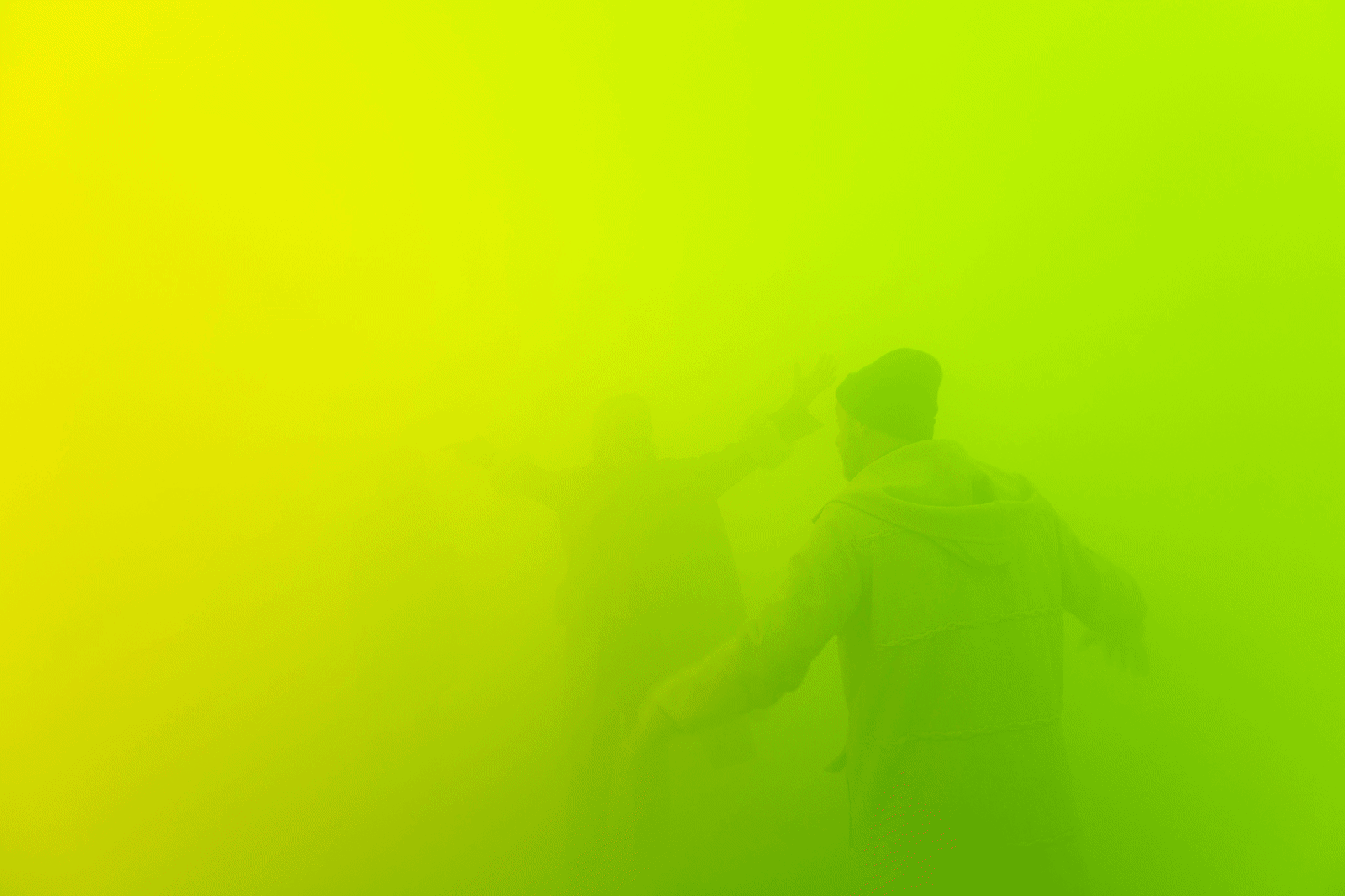
| Ann Veronica Janssens, Green, Yellow and Pink, 2017, artificial mist, green, yellow, and pink filters, dimensions variable. Exhibition view: Ann Veronica Janssens, Ich rede zu Dir wie Kinder reden in der Nacht, Esther Schipper, Berlin, 2017.
© VG Bild-Kunst, Bonn, 2021. Photos © Andrea Rossetti
| |
|
Ann Veronica Janssens’ site-specific installation was created on occasion of the artist’s 2017 solo exhibition at Esther Schipper, Ich rede zu Dir wie Kinder reden in der Nacht. Once visitors pass the threshold of the exhibition space, they find themselves immersed in an immaterial colored abstraction where any spatial or temporal landmark has disappeared.
A fog machine installed in a cabinet adjacent to the room fills the space with a dense mist bathed in a combination of natural and artificial light. Colored foil filters adhered to both the skylight and the fluorescent neon tubes tint the light passing through the mist, creating differently colored sections inside the gallery: lime green at the entrance, yellow at the center, pink at the back. Between each transition, two colors mix to create a third one: light green (green and yellow), orange (yellow and pink). An antechamber constructed at the entrance prevents any dispersion of the fog.
Janssens’ fog rooms are site-specific and can be installed in various types of sealable indoor spaces with either natural or artificial light, or a combination of both.
|
|
|
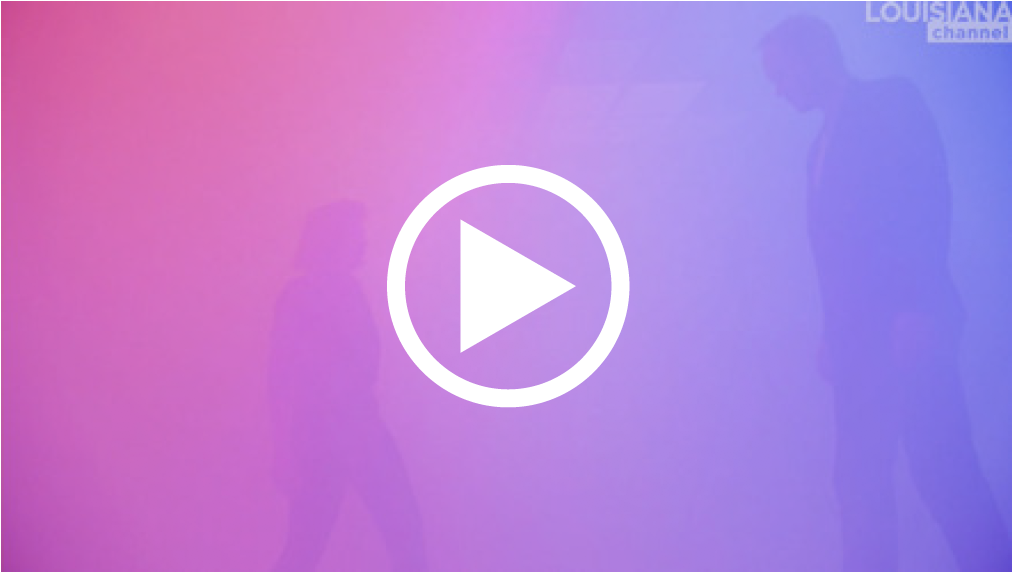
| Click the image to play the full video from Louisiana Channel.
| |
|
Dominique Gonzalez-Foerster |
|
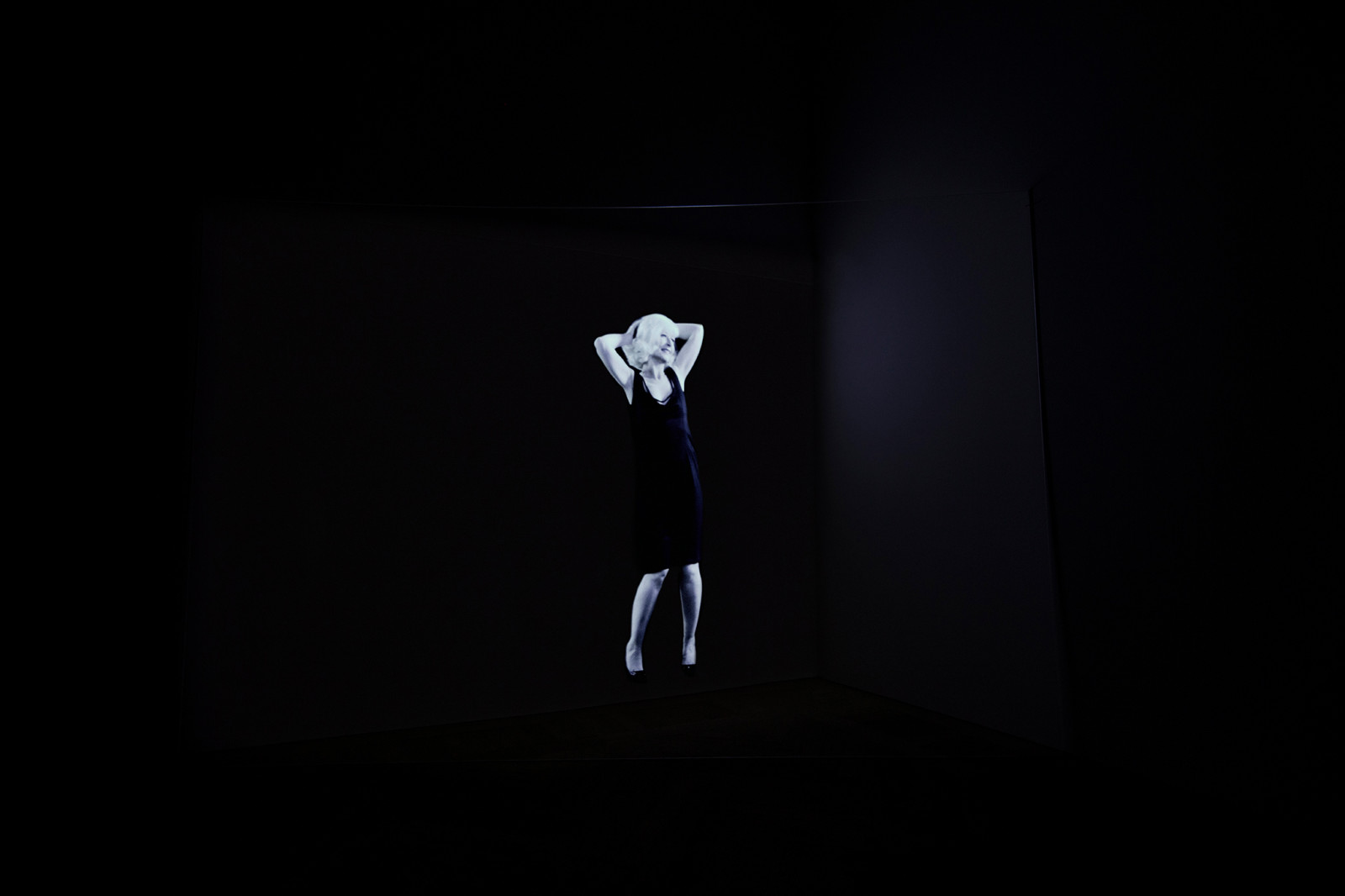
| Dominique Gonzalez-Foerster, CINEMA (QM.15), 2016, HD video, projector, Plexiglas screen, media
player, amplifier, speakers, 200 x 300 cm (projection screen), duration 08:10 min
© VG Bild-Kunst, Bonn, 2021. Photo © Andrea Rossetti
| |
|
Dominique Gonzalez-Foerster’s practice was one of the first to focus on the exhibition itself as an artistic medium. Her particular interest in space, alongside a preoccupation with literature, cinema, media, and technology has resulted in a uniquely cross-disciplinary practice, though her work primarily takes the form of installation, film, and most recently, performance — or what she terms, apparitions.
Cinema (QM.15) is a danced moment from Marilyn Monroe’s last film, The Misfits (1961), written by Arthur Miller and directed by John Huston.
The Misfits is at times harrowing in its display of the character’s weaknesses and forlornness. The moment depicts Monroe’s character Roslyn during a scene of great vulnerability: dancing alone in the dark landscape, she is being observed from the porch by aging cowhand Gay (Clark Gable) and his mechanic friend Guido (Eli Wallach), as well as her local acquaintance Isabelle (Thelma Ritter). |
|
|
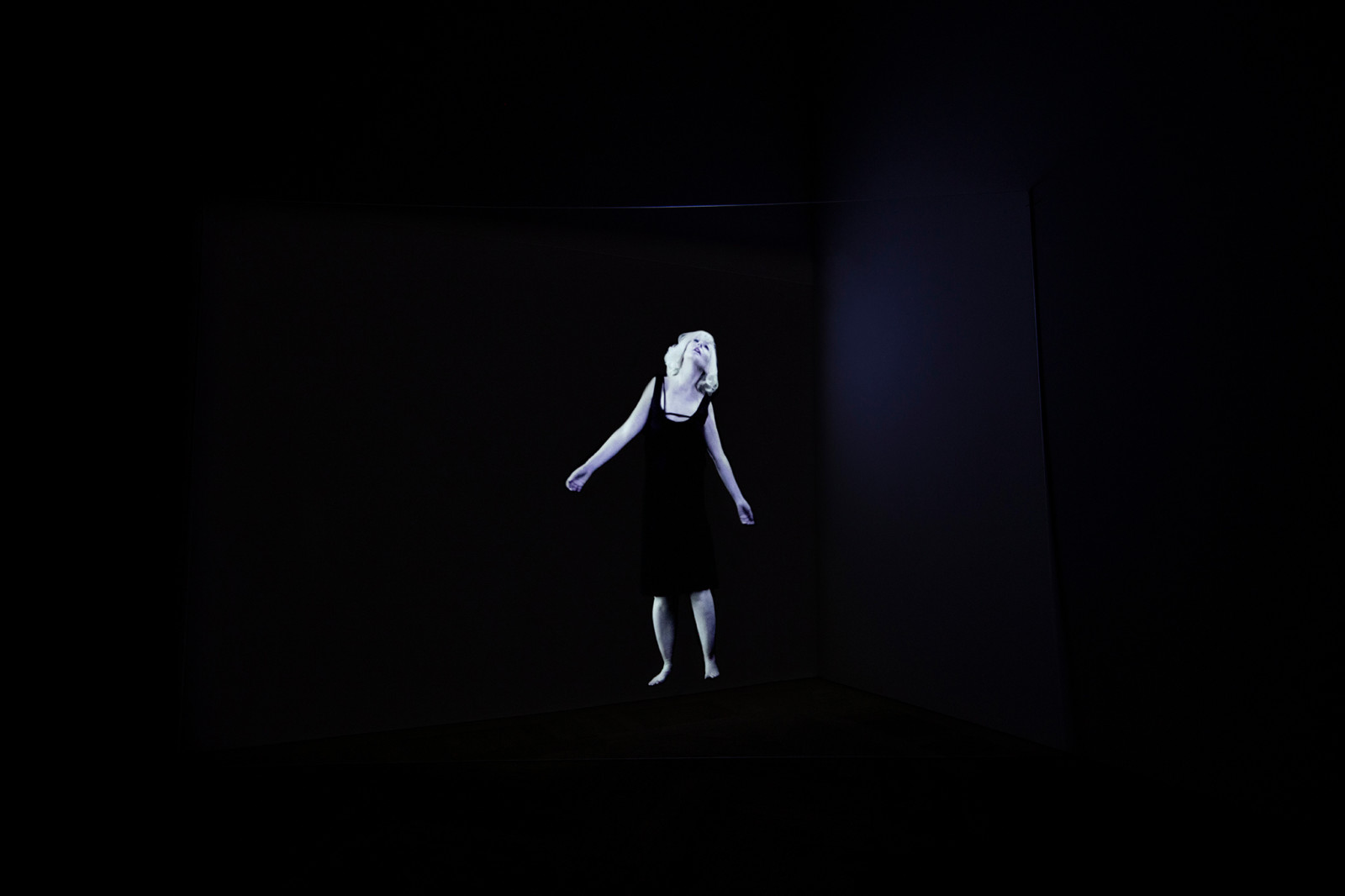
| Dominique Gonzalez-Foerster, CINEMA (QM.15), 2016, HD video, projector, Plexiglas screen, media
player, amplifier, speakers, 200 x 300 cm (projection screen), duration 08:10 min
© VG Bild-Kunst, Bonn, 2021. Photo © Andrea Rossetti | |
|
An ethereal image projected on a Plexiglas structure, Dominique Gonzalez-Foerster as Monroe is accompanied by musical compositions from the soundtrack of The Misfits: Roslyn and Compassion-Compassion for Guido by Alex North.
A sense of melancholy pervades the story about the group of outsiders in the desert, culminating in a scene of wild horses being rounded up. Reviewing the movie for The Village Voice, Jonas Mekas wrote: “Marilyn Monroe, the Saint of the Nevada desert. . . She haunts you, you’ll not forget her . . . It is MM that tells the truth in the movie, who accuses, judges, reveals. And it is MM who runs into the middle of the desert and in her helplessness shouts: “You are all dead, you are all dead!”—in the most powerful image of the film—and one doesn’t know if she is saying those words to Gable and [Eli] Wallach or to the whole loveless world. . . There is so much truth in her little details, in her reactions to cruelty, to false manliness, nature, life, death, that she is overpowering, one of the most tragic and contemporary characters of modern cinema.”
|
|
|
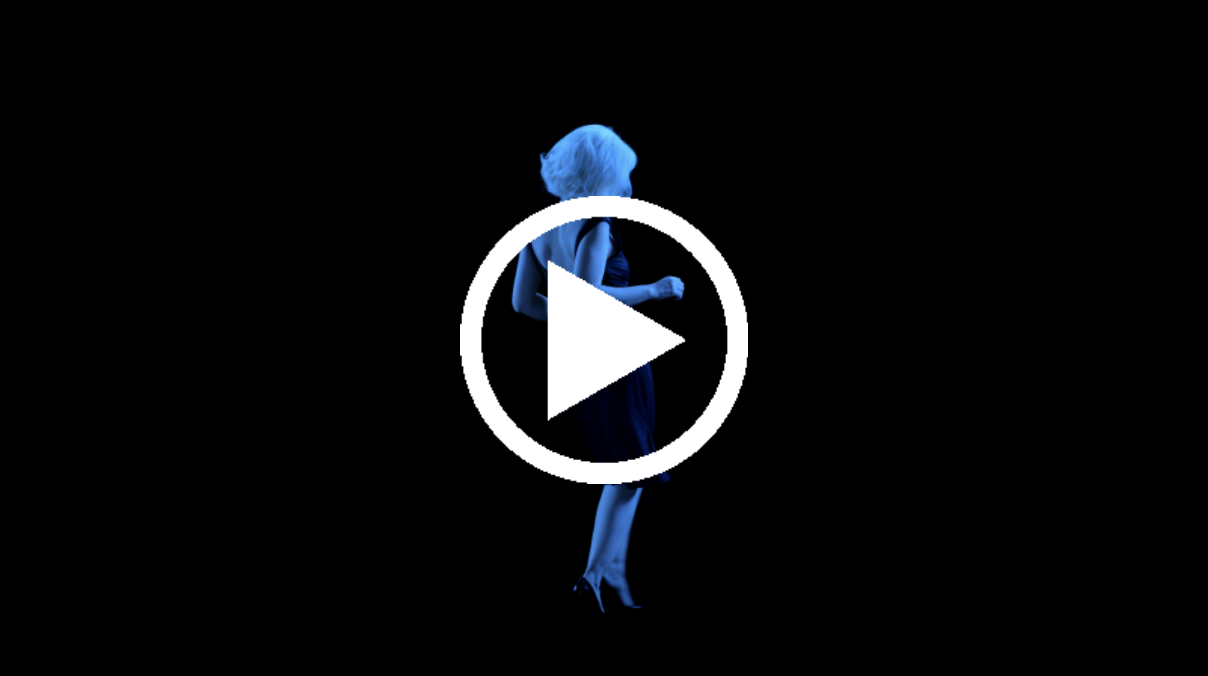
| Click the image to watch | |
|
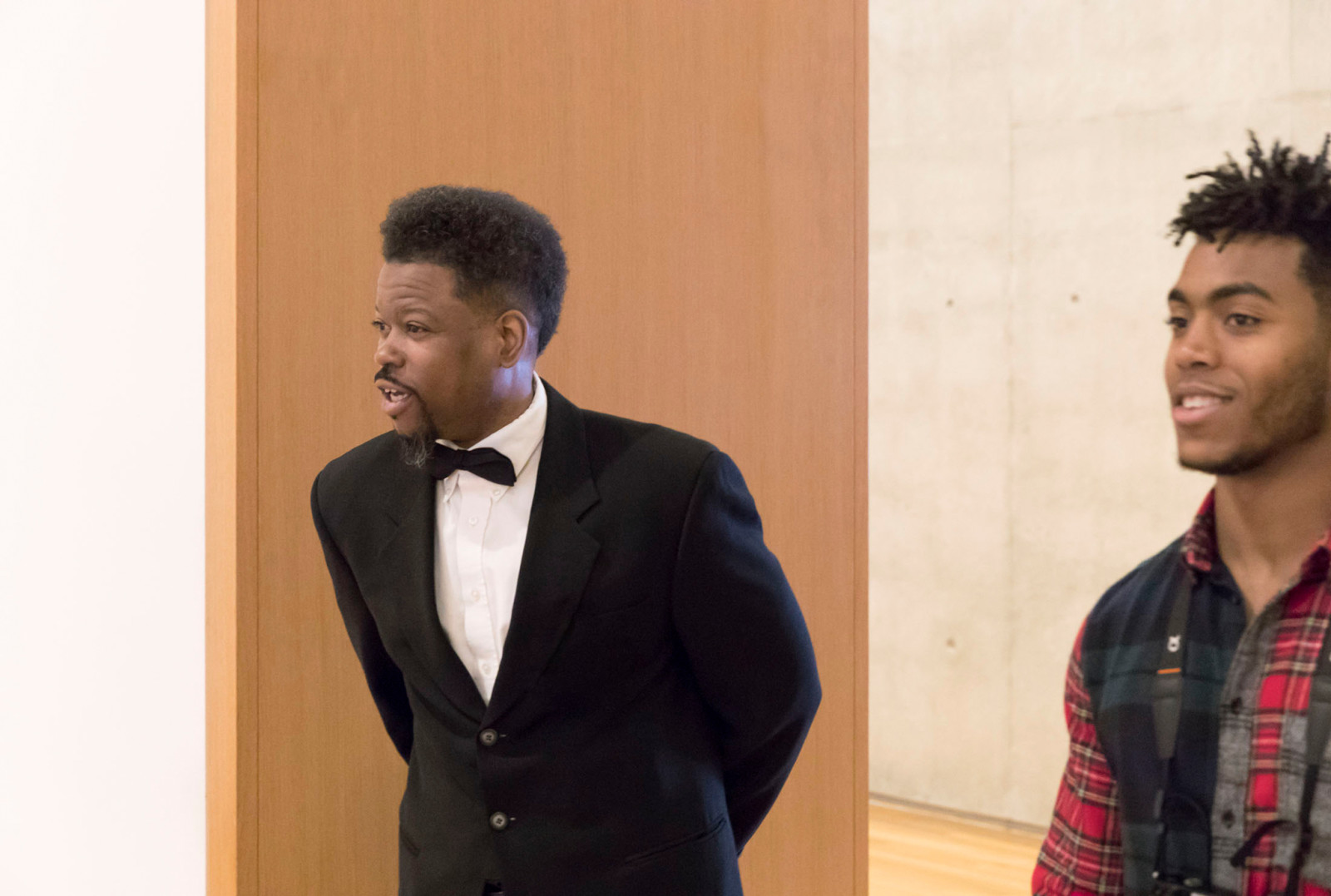
| Pierre Huyghe, Role Announcer, 2016, performance, variable
© Pierre Huyghe & VG Bild-Kunst, Bonn, 2021
| |
|
Pierre Huyghe’s (b. 1962) practice spans many media, including live situations, films, objects and drawings. His exhibitions are living organisms, in which interdependent, biotic and abiotic, real and symbolic agents – animals, humans, machines – are co-evolving.
The announcer stands on the opposite side of the door handle or at the right of the entrance of a space (in the middle of the entrance if it is very large). The Announcer welcomes the person who wants to enter the space.
He says “Hello” and follows with “Can I have your full name?” in the local language. When the person answers, the Announcer opens the door with his hand, not moving from his original position. After the person has passed the Announcer makes one or two steps into the space, loudly declares a name, and closes the door (if there is one). The person realizes the name is not their own. The action is repeated.
|
|
|

| Click the image to watch | |
|
Role Announcer is an iteration of another performance that originated in 2011, Name Announcer, first performed at Esther Schipper in 2011, and later staged during Huyghe’s three-part retrospective at Centre Pompidou, Paris; Museum Ludwig, Cologne, and Los Angeles County Museum of Art, Los Angeles (2014-15).
In the original performance, Hyughe’s announcer declared the name provided by the visitor (whether the name given by the visitor is real or improvised cannot be known), recalling royal court protocol and creating a particularly formal environment. By being publicly named visitors could feel both honored by this treatment but could also experience unease at an unexpected loss of anonymity.
With Role Announcer Huyghe further complicates this experience. Providing the announcer with a list of real-life, historical and fictional names (fictional personas are of ongoing interest to the artist), Huyghe sets the stage for disorientation and absurdity to ensue. The real-life persons, historical figures and fictional characters represent fields of knowledge, scientific and philosophical concepts and fictional and science fictional creations of alternative beings, gardens, landscapes, cities, societies and universes. Each name constitutes an oblique reference, creating, as an open-ended list, an intellectual sourcebook to major themes and developments in the artist's oeuvre.
Huyghe’s works are often designed to create fantastic and evocative experiences for the viewer, while drawing attention to the frame in which these experiences are held, particularly the space of the exhibition. By confronting the visitor as they cross the threshold into the exhibition, subsequent experiences become filtered through this encounter with one’s own subjectivity, whether real or imaginary. |
|
|

| Anri Sala, No Window No Cry (Alexis Et Philippe Dumont, Galerie Ravenstein, Brussels), 2014, music box, glass, metal window frame, 192,2 x 365,5 cm, Courtesy the artist and Esther Schipper, Berlin
© VG Bild-Kunst, Bonn, 2021. Photo © Isabelle Arthuis
| |
|
The oeuvre of Anri Sala explores the relationships between music and narrative, architecture and film, interleaving qualities of different media in both complex and intuitive ways to produce works in which one medium takes on the qualities of another.
The work is from an ongoing series of unique site-specific works of a miniature small brass music box cylinder enclosed in a sheet of glass. The glass is hollowed with a small concave area where the wind-up handle is located, thus the music box can be wound up and played.
|
|
|

| Anri Sala, No Window No Cry (Alexis Et Philippe Dumont, Galerie Ravenstein, Brussels), 2014, music box, glass, metal window frame, 192,2 x 365,5 cm, Courtesy the artist and Esther Schipper, Berlin
© VG Bild-Kunst, Bonn, 2021. Photo © Isabelle Arthuis | |
|
No Window No Cry (Alexis Et Philippe Dumont, Galerie Ravenstein, Brussels) was originally conceived for Galerie Ravenstein in Brussels: an important pedestrian connection between downtown and uptown Brussels that leads to the Gare Centrale (Central Station). Designed as a shopping gallery, Galerie Ravenstein was built in 1954–58 by Alexis and Philippe Dumont. The gallery has been listed as a national monument since 2009.
Each work in the series (nine in total) features a different song. In the case of No Window No Cry (Alexis Et Philippe Dumont, Galerie Ravenstein, Brussels), the music box plays The Clash’s punk anthem Should I Stay or Should I Go (from their 1981 iconic album Combat Rock).
|
|
|

| Philippe Parreno, Fade to Black, 2009, phosphorescent ink on paper, 4 parts: 157,5 x 118 cm (each); 315 x 236 cm (overall)
Photo © Andrea Rossetti
| |
|
Philippe Parreno (b. 1964) radically redefines the exhibition experience by taking it as a medium, placing its construction at the heart of his process.
Fade to Black is a body of work that Philippe Parreno began in 2003, alone or in collaboration with other artists. The Fade to Black screen-prints are made with phosphorescent ink on paper. The printed image is invisible in the light but in the darkness it is present with intense and ghostly neon glow.
On occasion of his 2009 solo exhibition at the Centre Pompidou, Parreno specially produced a new Fade to Black (the fifteenth in the series) consisting of four screen-prints placed side by side on a wall to create an image: shadows of children playing with stick puppets. The image refers to the work Parade?: “Jeunes talents” Series (2009), a group of stick puppets leaning against a wall, which was also included in the exhibition. The photograph was taken during a workshop at the Centre Pompidou where children wandered in the exhibition space holding the stick puppets.
The puppet is a recurrent motif of Parreno’s work. In 1993, the artist created his first set of hand-puppets on occasion of the 45th Venice Biennale. Titled No More Reality (Suite et fin), they were made of poster cut-outs with reproductions of works by Yves Klein, Matisse, Picasso, and Renoir, and were placed against a wall, inviting visitors to participate in a shadow play. These puppets echoed a fake demonstration staged by the artist in a French elementary school two years earlier. Titled No More Reality (La Manifestation), the performance – and resulting film – featured children demonstrating in their schoolyard, holding banners that read “No More Reality”. The motif of the puppet has since become central in Parreno’s work: from ventriloquist puppets created with his long-time collaborator Rirkrit Tiravanija to a more recent exploration of the automaton.
The Fade to Black series is dedicated to previous works, unrealized projects, or fragments of memory of the artist and, sometimes, his collaborators (Rirkrit Tiravanija, Liam Gillick and Pierre Huyghe). Just like abandoned proposals and ideas are fading away in the human memory, the glow of the phosphorescent Fade to Black drawings gradually loses its intensity as the images sink back into the darkness. At this point the lights have to be turned on in order to recharge the phosphorescent ink. Like ghost images of lost works, this series recalls the process of memory—a recurrent motif in Parreno’s work—and questions the visibility conditions of a work of art.
|
|
|
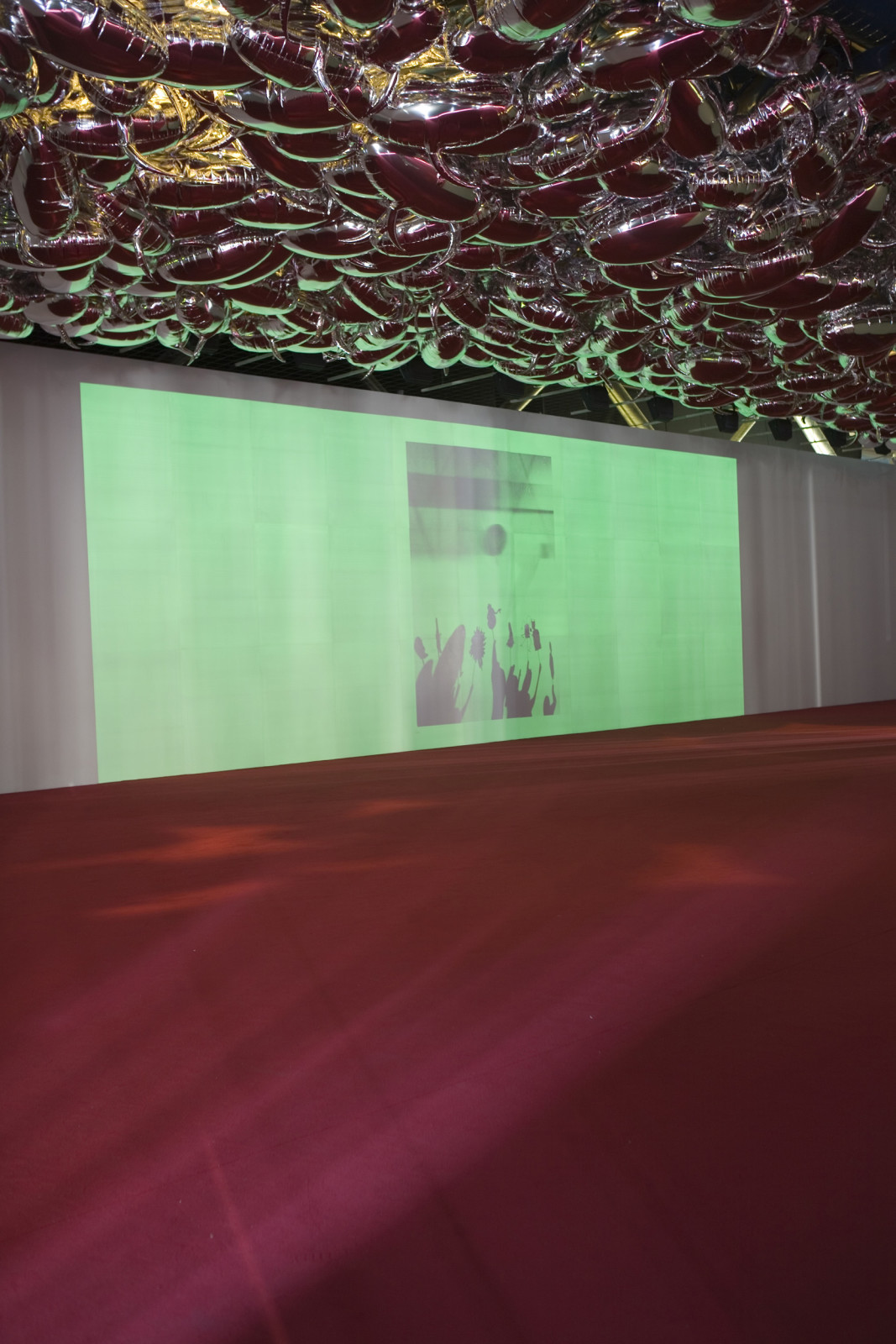
| Philippe Parreno, Fade to Black, 2009, phosphorescent ink on paper, 4 parts: 157,5 x 118 cm (each); 315 x 236 cm (overall)
Exhibition view: Philippe Parreno, 8 Juin 1968 – 7 Septembre 2009, Centre Pompidou, Paris, 2009
| |
|
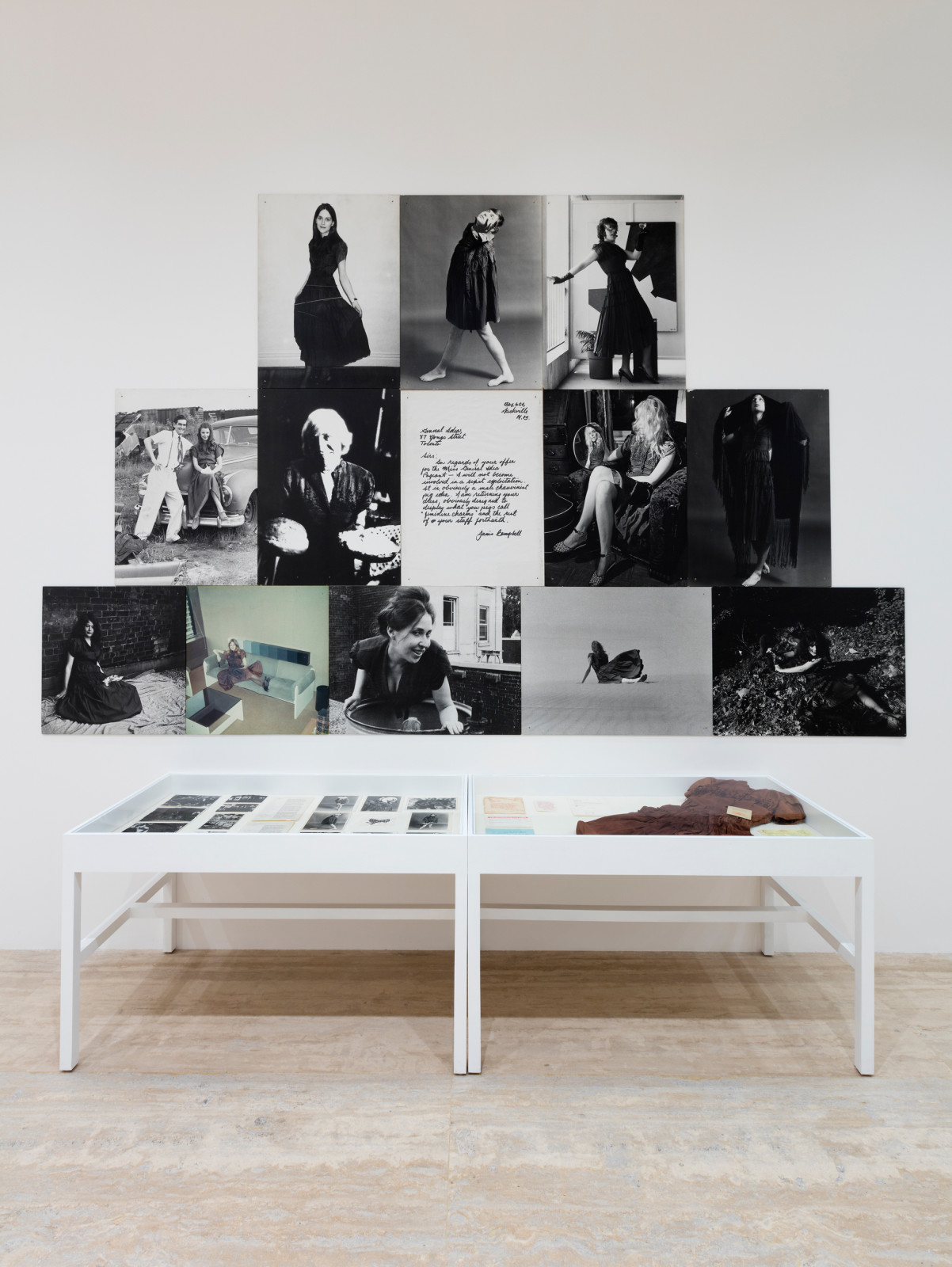
| General Idea, The 1971 Miss General Idea Pageant Documentation, 1971, found cellulose acetate “taffeta” dress with embroidery, gelatin silver prints, Chromogenic print, Photostat, and assorted ephemera, dimensions variable
Exhibition view: General Idea: Broken Time, Museo Jumex, Mexico City, 2016–17
Photo © Andrea Rossetti
| |
|
Throughout its 25-year-long career, prominent Canadian artists’ group General Idea—formed in 1969 by AA Bronson (b. Michael Tims, 1946), Felix Partz (b. Ronald Gabe, 1945-1994) and Jorge Zontal (b. Slobodan Saia-Levi, 1944-1994)—produced an important body of work in various media and formats, which continues to be a reference point for generations of artists around the world.
General Idea’s early works (1969–1984) mimicked popular culture formats, such as beauty pageants and mainstream magazines, in order to forward a critical and satirical view of art, culture and media. Their series of faux beauty pageants, begun in 1970, satirized glamour, fame and the art world. The notion of glamour, the myth of the artist, and the character they created, “Miss General Idea” became key motifs in the group’s iconography and mythology.
The 1971 Miss General Idea Pageant was the second in the group’s series of faux beauty pageants. General Idea mailed out entry kits to sixteen chosen “finalists” (comprised of friends and artists across North America). The invitation promised potential competitors the chance to win “fame, fun, and fortune.” Each kit contained a letter from Miss General Idea 1969 Granada Gazelle, rules and regulations, an application form, and a pageant gown. Thirteen artists responded, submitting photographs that featured their submission for Miss General Idea dressed in the provided gown from the kit, returning as well as the completed application forms and the gown.
|
|
|
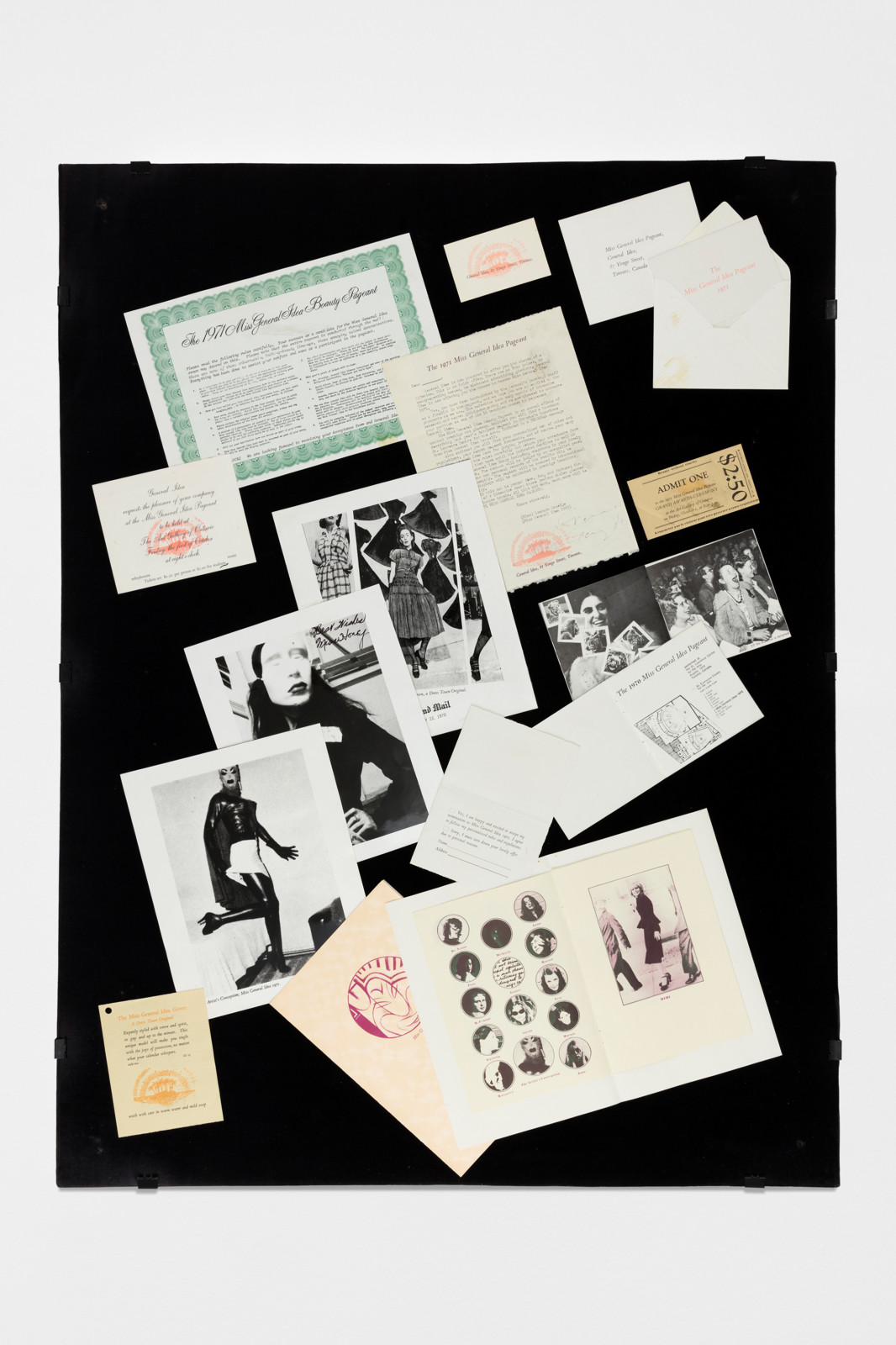
| General Idea, The 1971 Miss General Idea Pageant Documentation, 1971 (detail). Ephemera from the 1971 Miss General Idea Pageant Entry Kit
Photo © Andrea Rossetti
| |
|
The photographic submissions were enlarged and mounted on panels and exhibited at an artist-run center in Toronto, A Space, for the pageant judges to do their preliminary viewings. The 1971 Miss General Idea Pageant – Grand Awards Ceremony was held at the Art Gallery of Ontario on October 1, 1971.
It was scripted and included music, speeches and prizes. The items from the entry kit were assembled, along with additional ephemera (pageant invitation, ticket and programme), and mounted onto a velvet panel, which was displayed on an easel. A jury comprised of various well-known figures in the Toronto art scene judged the competition, and the 1971 Miss General Idea crown was awarded to Vancouver artist Michael Morris, who at that moment announced his new name: Marcel Dot. The judges declared that his submission succeeded in “capturing ‘Glamour’ without falling into it”. The other Miss General Ideas, of the years 1968, 1969, and 1970, were: Mimi Paige, Granada Gazelle, and Miss Honey (Miss General of 1968 and 1969 were retrospective crownings).
|
|
|

| General Idea, The 1971 Miss General Idea Pageant Documentation, 1971 (detail). The 1971 Miss General Idea Pageant Winner Marcel Dot, 101,9 x 76,3 cm
Photo © Vincent Trasov
| |
|
Spotlight is a new weekly presentation focusing on an artwork or a group of works. |
|
|
|
Ann Veronica Janssens
Green, Yellow and Pink, 2017
Artificial mist, green, yellow, and pink filters
Dimensions variable
|
|
Angela Bulloch
Pentagon Totem: Tree, 2020
Corian, paint
150 x 50 x 30 cm
|
|
|
All Access is a new series of online visits to exhibitions that are currently closed to the public. As museums and galleries around the world remain closed, the series takes us into these spaces with the artists and curators as guides. |
|
|
Pierre Huyghe – Sun Rise | Sun Set, Schinkel Pavillon
|
|
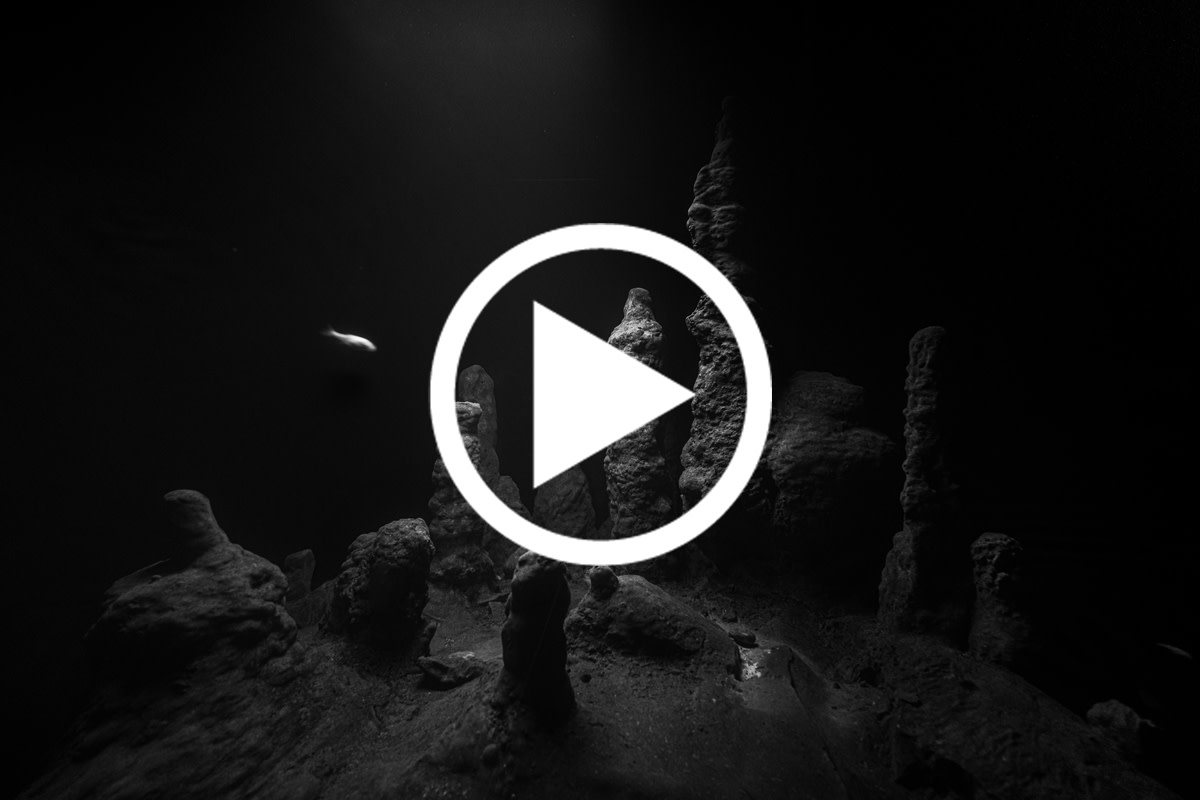
| Pierre Huyghe, Circadian Dilemma (El Día del Ojo), 2017, aquarium, Astyanax Mexicanus (eyeless and with eyes), algae, cave scan cast in concrete, black switchable glass, geo-localised program, 137.5 × 123 × 164.1 cm
© VG Bild-Kunst, Bonn, 2021. Photo © Rex Chu | |
|
Sun Rise | Sun Set with Pierre HuygheSchinkel Pavillon, Berlinthrough July 25, 2021 www.schinkelpavillon.deSun Rise | Sun Set brings together contemporary and 20th century artists to form a multi-layered response to the fast unfolding ecocatastrophe. The selected works permeate one another, creating small organisms and turning Schinkel Pavillon into a surreal landscape, highlighting the interconnectivity between humans, animals, plants, inanimate objects, technologies and non-beings. Due to the current COVID-19 restrictions the exhibition opens by appointment only. Includes in the exhibition are two works by Pierre Huyghe. The video focuses on the room in which Circadian Dilemma (Dia del Ojo) is installed. The work is part of a series of aquarium works in which the artist creates cyclically-oriented underwater scenarios. The landscape of the water basin is modelled on a Mexican cave and is populated by six fish of the species Astyanax mexicanus, along with microscopic bacteria and algae. Circadian Dilemma (Dia del Ojo) forms an independent biosphere that reacts autonomously to the respective climatic conditions of its surrounding. The transparency of the dimmable glass panes is controlled by a geolocation program while the lighting conditions inside the aquarium are adjusted according to the weather and environmental data on site – taking account of wind, air pressure and temperature.
|
|
|

| Exhibition view: Sun Rise | Sun Set, Schinkel Pavillon, Berlin, 2021
Photo © Andrea Rossetti
| |
|
David Claerbout at Garage Museum, Moscow |
|
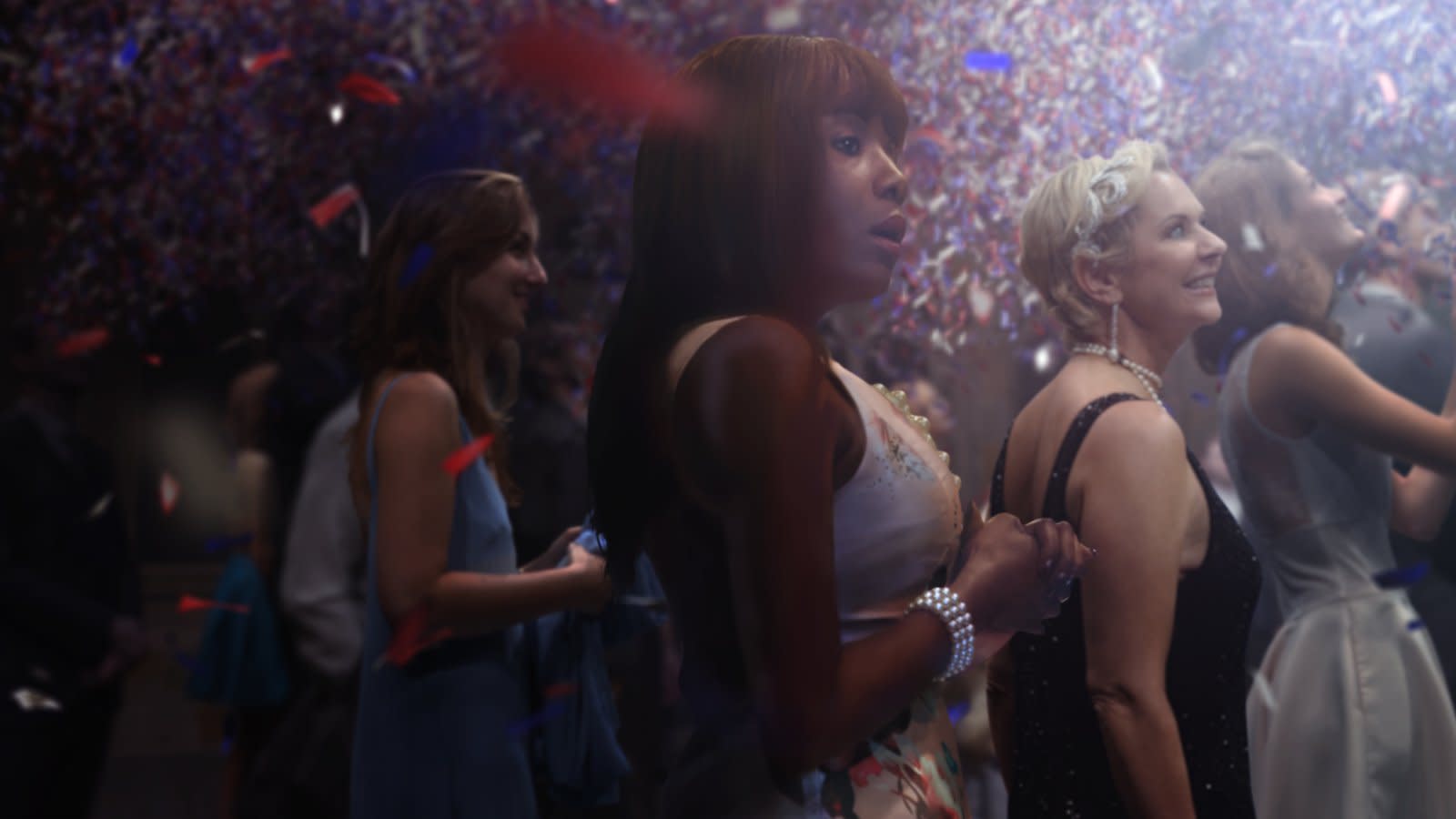
| David Claerbout, the “confetti” piece, 2015-2018, video still, double channel video projection, 3D animation, silent, color, 18’ 25”
Film still © David Claerbout & VG Bild-Kunst, Bonn, 2021 | |
|
David ClaerboutUnseen Sound Garage Museum, Moscow March 26 – May 2, 2021 www.garagemca.orgUnseen Sound is the first solo exhibition of Belgian artist David Claerbout in Russia. His work is best defined as a hybrid, where media dissolve into one another using video, photography, film, and 3D to create images that question our perceptions and expectations. The exhibition brings together four works that span a period of more than ten years, and show the artist’s increasing occupation with what he describes as “dark optics,” a term he uses to describe the contemporary state of the image. All of the works presented in Unseen Sound capture single moments stretched in time and space. This expansion reveals new layers of reality behind seemingly trivial images, and new characters emerge. As the title of the exhibition— Unseen Sound—indicates, these works visualize sound as a central event that, nevertheless, remains beyond aural perception. Sections of a Happy Moment (2007) and The Algiers' Sections of a Happy Moment (2008) capture moments of a street ball game. The Quiet Shore (2011) is a series of beach scenes shot during a loud splash. Set at a grand reception, the “confetti” piece (2015–2018 ) shows the second when the fireworks of confetti rain down. For Claerbout, digital materiality will not remain as virtual reality but will attempt to penetrate as many aspects of life as possible, altering optical and material habits. Lens-based images are already part of the past, and will be replaced by dark optics. A short excerpt from their digital preview is online. Please click the image below.
|
|
|

| Click the image to watch the introduction to the exhibition | |
|
Karin Sander at Kunsthalle Tübingen |
|
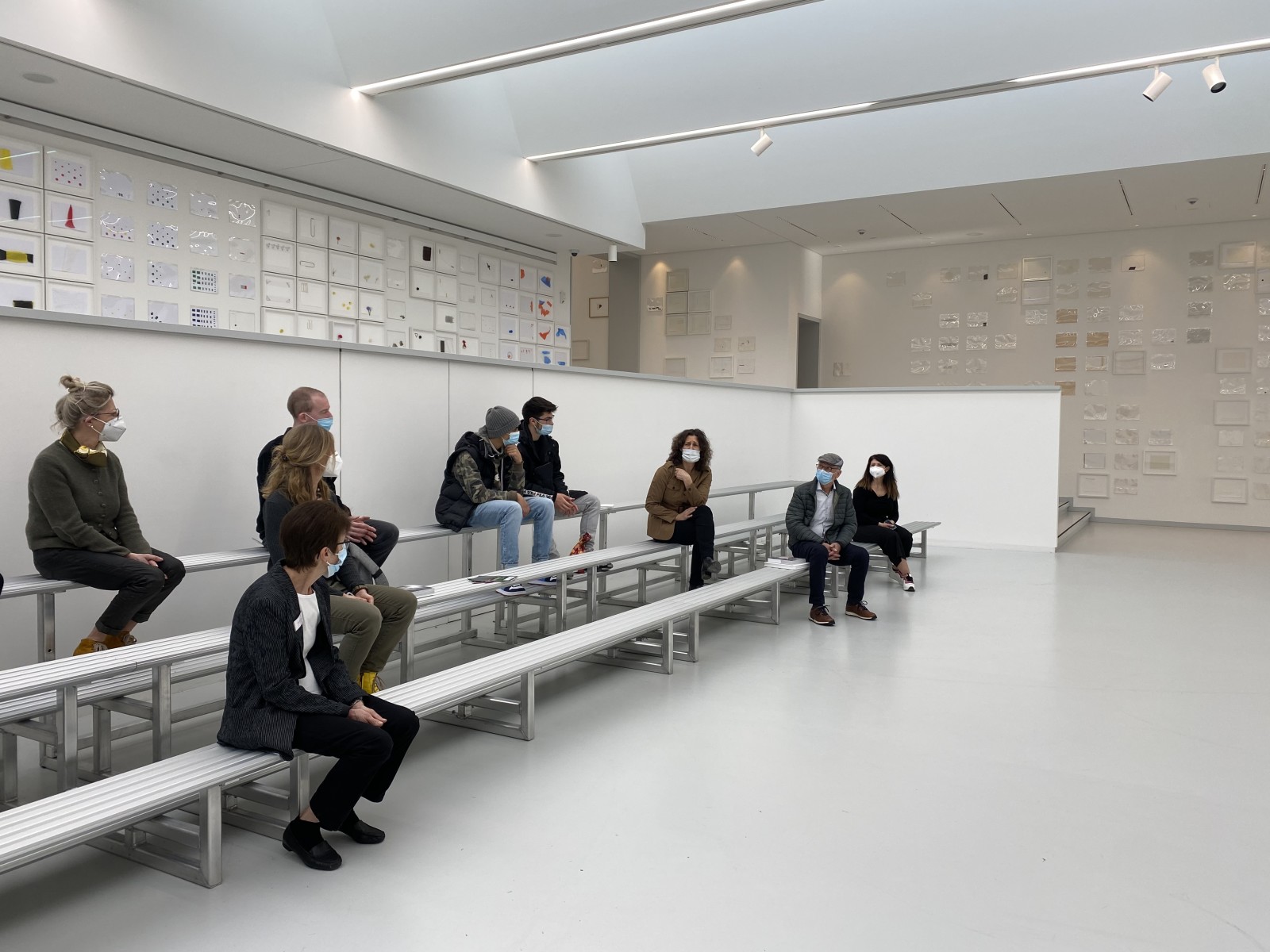
| Exhibition view: Karin Sander, Kunsthalle Tübingen, 2021
Photo © Studio Karin Sander | |
|
Karin SanderKunsthalle Tübingen March 27 – July 4, 2021 www.kunsthalle-tuebingen.deVirtual OpeningMarch 26, 2021, 7pm via the website of Kunsthalle Tübingen Followed by a Virtual Exhibition Tour on ZOOMhttps://ethz.zoom.us/j/95554528080
Meeting-ID: 955 5452 8080 Kunsthalle Tübingen is dedicating a solo exhibition to Karin Sander, running from March 27 through July 4, 2021. Concurrent to the exhibition, the book Office Works will be published by Kunsthalle Tübingen and Verlag der Buchhandlung Walther und Franz König. It includes the entire series of the artist's Office Works with over 1500 illustrations, 300 in original sizes on 680 pages. An essay by John Waters and an interview by director Nicole Fritz and Karin Sander accompany this comprehensive compendium of works. The concept of the book was developed in collaboration with Andreas Uebele. The book is a limited edition of 300 copies, signed and numbered.
|
|
|
David Claerbout
2019
Publisher: Kunsthaus Bregenz
Language: English, German
Available here
|
|
|
Ann Veronica Janssens
Hot Pink Turquoise
2020
Publisher: Louisiana Museum of Art and South London Gallery
Language: English
Available here
|
|
|
Dominique Gonzalez-Foerster
1887 – 2058
2016
Publisher: Prestel Publishing
Language: English
Available here
|
|
|
Pierre Huyghe
Dorothea von Hantelmann, Pierre Huyghe, 2019
Publisher: Serpentine Galleries, Koenig Books, Luma Foundation
Available here
|
|
|
Dorothea von Hantelmann
How to Do Things With Art
2010
Publisher: jrp|editions
Language: English
Available here
|
|
|
Philippe Parreno
H {N)Y P N(Y} OSIS HYPOTHESIS
2017
Publisher: Mousse Publishing
Language: English
Available here
|
|
|
Anri Sala
Bendings: Four Variations on Anri Sala
Peter Szendy, 2019
Publisher: Edition Mudam Luxembourg, Mousse Publishing
Language: English, French
Available here
|
|
|
Karin Sander
A–Z
2019
Publisher: Walther König
Language: English, German
Available here
|
|
|
Hito Steyerl
I Will Survive
2020
Publisher: Spector Books
Language: English, German
Available here
|
|
|
|
|